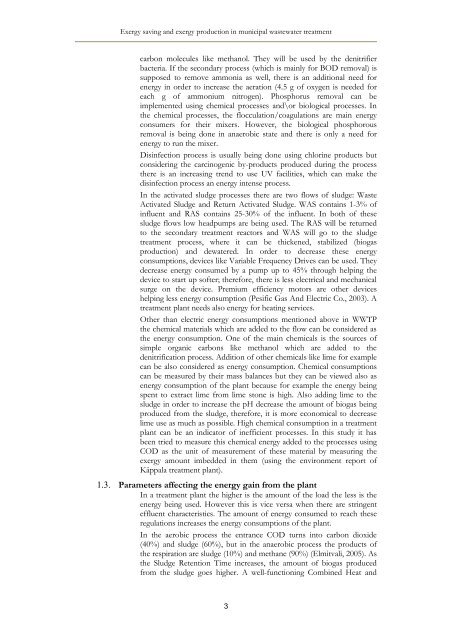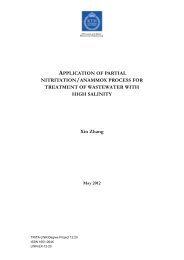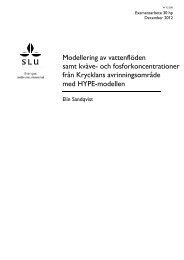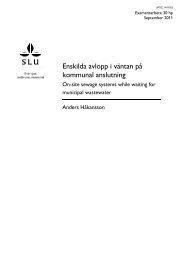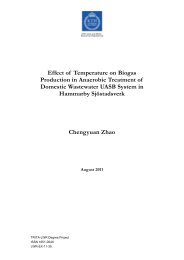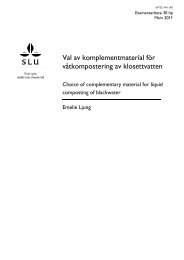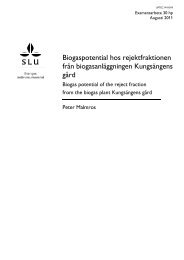Exergy saving and exergy production in municipal wastewater ...
Exergy saving and exergy production in municipal wastewater ...
Exergy saving and exergy production in municipal wastewater ...
Create successful ePaper yourself
Turn your PDF publications into a flip-book with our unique Google optimized e-Paper software.
<strong>Exergy</strong> <strong>sav<strong>in</strong>g</strong> <strong>and</strong> <strong>exergy</strong> <strong>production</strong> <strong>in</strong> <strong>municipal</strong> <strong>wastewater</strong> treatment<br />
carbon molecules like methanol. They will be used by the denitrifier<br />
bacteria. If the secondary process (which is ma<strong>in</strong>ly for BOD removal) is<br />
supposed to remove ammonia as well, there is an additional need for<br />
energy <strong>in</strong> order to <strong>in</strong>crease the aeration (4.5 g of oxygen is needed for<br />
each g of ammonium nitrogen). Phosphorus removal can be<br />
implemented us<strong>in</strong>g chemical processes <strong>and</strong>\or biological processes. In<br />
the chemical processes, the flocculation/coagulations are ma<strong>in</strong> energy<br />
consumers for their mixers. However, the biological phosphorous<br />
removal is be<strong>in</strong>g done <strong>in</strong> anaerobic state <strong>and</strong> there is only a need for<br />
energy to run the mixer.<br />
Dis<strong>in</strong>fection process is usually be<strong>in</strong>g done us<strong>in</strong>g chlor<strong>in</strong>e products but<br />
consider<strong>in</strong>g the carc<strong>in</strong>ogenic by-products produced dur<strong>in</strong>g the process<br />
there is an <strong>in</strong>creas<strong>in</strong>g trend to use UV facilities, which can make the<br />
dis<strong>in</strong>fection process an energy <strong>in</strong>tense process.<br />
In the activated sludge processes there are two flows of sludge: Waste<br />
Activated Sludge <strong>and</strong> Return Activated Sludge. WAS conta<strong>in</strong>s 1-3% of<br />
<strong>in</strong>fluent <strong>and</strong> RAS conta<strong>in</strong>s 25-30% of the <strong>in</strong>fluent. In both of these<br />
sludge flows low headpumps are be<strong>in</strong>g used. The RAS will be returned<br />
to the secondary treatment reactors <strong>and</strong> WAS will go to the sludge<br />
treatment process, where it can be thickened, stabilized (biogas<br />
<strong>production</strong>) <strong>and</strong> dewatered. In order to decrease these energy<br />
consumptions, devices like Variable Frequency Drives can be used. They<br />
decrease energy consumed by a pump up to 45% through help<strong>in</strong>g the<br />
device to start up softer; therefore, there is less electrical <strong>and</strong> mechanical<br />
surge on the device. Premium efficiency motors are other devices<br />
help<strong>in</strong>g less energy consumption (Pesific Gas And Electric Co., 2003). A<br />
treatment plant needs also energy for heat<strong>in</strong>g services.<br />
Other than electric energy consumptions mentioned above <strong>in</strong> WWTP<br />
the chemical materials which are added to the flow can be considered as<br />
the energy consumption. One of the ma<strong>in</strong> chemicals is the sources of<br />
simple organic carbons like methanol which are added to the<br />
denitrification process. Addition of other chemicals like lime for example<br />
can be also considered as energy consumption. Chemical consumptions<br />
can be measured by their mass balances but they can be viewed also as<br />
energy consumption of the plant because for example the energy be<strong>in</strong>g<br />
spent to extract lime from lime stone is high. Also add<strong>in</strong>g lime to the<br />
sludge <strong>in</strong> order to <strong>in</strong>crease the pH decrease the amount of biogas be<strong>in</strong>g<br />
produced from the sludge, therefore, it is more economical to decrease<br />
lime use as much as possible. High chemical consumption <strong>in</strong> a treatment<br />
plant can be an <strong>in</strong>dicator of <strong>in</strong>efficient processes. In this study it has<br />
been tried to measure this chemical energy added to the processes us<strong>in</strong>g<br />
COD as the unit of measurement of these material by measur<strong>in</strong>g the<br />
<strong>exergy</strong> amount imbedded <strong>in</strong> them (us<strong>in</strong>g the environment report of<br />
Käppala treatment plant).<br />
1.3. Parameters affect<strong>in</strong>g the energy ga<strong>in</strong> from the plant<br />
In a treatment plant the higher is the amount of the load the less is the<br />
energy be<strong>in</strong>g used. However this is vice versa when there are str<strong>in</strong>gent<br />
effluent characteristics. The amount of energy consumed to reach these<br />
regulations <strong>in</strong>creases the energy consumptions of the plant.<br />
In the aerobic process the entrance COD turns <strong>in</strong>to carbon dioxide<br />
(40%) <strong>and</strong> sludge (60%), but <strong>in</strong> the anaerobic process the products of<br />
the respiration are sludge (10%) <strong>and</strong> methane (90%) (Elmitvali, 2005). As<br />
the Sludge Retention Time <strong>in</strong>creases, the amount of biogas produced<br />
from the sludge goes higher. A well-function<strong>in</strong>g Comb<strong>in</strong>ed Heat <strong>and</strong><br />
3


